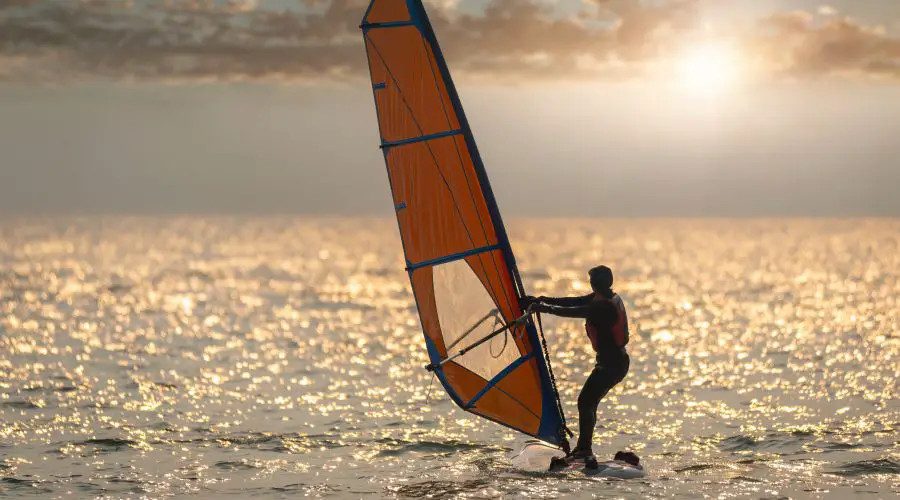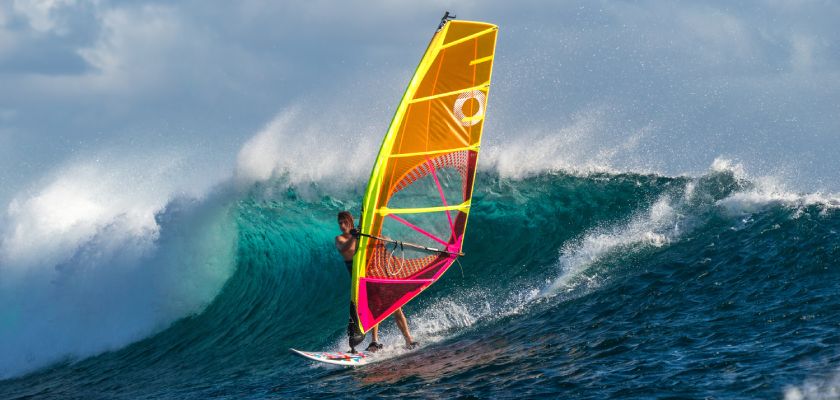“Windsurfing” is an English term meaning “sailing with the wind”. It is made up of the English words “wind” and “surf”. Thus, the sport is literally the practice of surfing on the waves taking advantage of the force of the wind. That’s the basic idea of the sport, however, like any other discipline, there are windsurfing rules.
And for those who are laypeople or only know the basics about the competition, it can seem very difficult to understand what can, what can’t and what an athlete must do to be champion of a race.
That’s why we’ve created this basic, straightforward guide to the windsurfing rules, with everything that beginners or curious spectators need to know to enjoy the sport.
Join our free WhatsApp community and receive daily tips, news and trivia on more than 50 sports! Click here to join.
Windsurfing rules: everything you need to know to practice or watch the sport
The main windsurfing rules include:
- Mandatory use of a life jacket
- Respect the right of way: steer clear of other sailors and avoid collisions.
- Priority rules: returning sailors have priority over those who are going.
- Stay on the board: if an athlete leaves the board during the competition, they may be disqualified.
- All physical contact with another athlete is prohibited during competitions. Exception only for accidental contact;
- It is considered a false start if any sailor starts before the judge gives the start.
Undoubtedly, the main focus of windsurfing rules is to ensure the safety of athletes during training and competitions.
For this reason, some unofficial rules also require the attention of the athlete practicing the sport, including keeping away from bathers if there are people in the water while they perform their maneuvers.
How does windsurfing scoring work?
In windsurfing races, the course is marked out by buoys, with competitors sailing around them in a certain order.
These athletes are judged on specific criteria, such as:
- speed
- technique
- style;
- execution of the maneuvers.
In the windsurfing rules for Olympic Games, the format of the competition is that of fleet racing, where the boats race around a course.
The better your position in a race, the lower your score. For example, the winner of a race gets one point, second place gets two and so on.
So, unlike most sports, the aim of most sailing disciplines is to score the fewest points.
After the series of races, the points are added up to determine the rankings.
Each event has a number of races in the qualifying stage and the points from the race with the worst score are discarded. Depending on the number of races in the qualifying stage, up to three scores can be discarded.
The best-placed athletes in each event advance to the final phase.
In windsurfing, the format is usually direct elimination in the quarterfinals and semifinals, forming a final with three athletes.
In 2024, for the first time the IQFOiL windsurfing category will be part of the list of Olympic sports. To learn a little more about the category, watch the video below, summarizing the IQFOIL World Championships that took place in 2022.
Even if you’ve mastered the windsurfing rules that we’ve shared above, it’s important that you know that there are several disciplines within windsurfing. In practice, World Sailing recognizes 14 windsurfing classes, including IQFOiL, which will be at the Olympics for the first time.
Each of these “disciplines” has its own techniques and some rules may also vary, ok?
How is windsurfing practiced?
Understanding how the sport is practiced also helps you understand the windsurfing rules, which can seem a little confusing, whether you want to start practicing the sport or just want to sit in front of the TV and enjoy the competition.
Whatever your case may be, our mission here is to help you, so we’ve listed a few points of attention about how the sport works.
Positioning on the board
The windsurfer starts lying on the board with the sail positioned perpendicular to the direction of the wind.
They hold the sail with one hand, while the other holds the handle.
The athlete can also climb onto the board, kneel down and then stand up holding the sail.
Controlling the sail
One of the most delicate aspects of the sport is controlling the sail. To do this, you need to master the boom, the name given to the accessory between the sail and the athlete, which allows you to steer and hold the sail.
It is with the boom that the athlete adjusts the position of the sail according to the direction of the wind.
Next, the sail must be directed forward to accelerate and backward to decelerate or stop.
You need to keep your arms outstretched and your shoulders relaxed to control the sail effectively.
Steering the board
As the sportsperson positions the sail, the board will be steered.
In other words, the sail is used to push the board through the wind, and the boom is used to position the sail.
To turn right, you have to move the sail to the left and lean your body backwards.
To turn left, you have to do the opposite: move the sail to the right.
The feet help to adjust the position on the board and balance the weight during the turn.
Sailing with the wind
When sailing, it is essential to make the most of the wind by positioning the sail at an ideal angle to the wind direction.
To do this, athletes need to be aware of changing wind conditions (and directions) and adjust the sail as necessary.
Practicing Maneuvers
As windsurfers gain confidence, they can experiment with maneuvers such as jibes, tacks and jumps, which help them compete and qualify for the final stages of tournaments.
Keep an eye out for these maneuvers during the races, so that the sport becomes even more exciting, even for those who are just cheering!
Beyond the windsurfing rules: answering the main questions about the sport
What is Windsurfing?
Windsurfing is a water sport in which the sailor stands on a board propelled by a sail that catches the wind, using it to take the equipment in the desired direction and perform maneuvers, while completing the obligatory course, usually demarcated by buoys.
Is windsurfing an Olympic sport?
Yes, windsurfing has been an Olympic discipline since 1984, with categories such as the Widnglider, Lechner Division II, Lechner A-390, Mistral One Design and RS:X. In 2024, in Paris, the IQFOiL joins the Olympic Games roster and promises spectators plenty of thrills.
Does Brazil have a chance in windsurfing at the Olympic Games?
Yes! Mateus Isaac is guaranteed a place at the 2024 Olympics. The athlete is one of Brazil’s highlights in IQFoil, a sport that will make its debut at the Olympic Games. The place was won after Mateus came 16th in the Sailing World Cup in The Hague, Holland, in 2023.

With the windsurfing rules in your hands, your fans will be even stronger, or maybe you’ll embark on this new challenge and start practicing the sport? What do you think?
And if you like sports, I think you’ll enjoy the articles below:
- Types and types of canoeing: speed, slalom and more
- Badminton rules: how to play, serves, equipment and more
- Sand soccer: history, fundamentals, rules and plays
Join our free Whatsapp community and receive daily tips, news and trivia on over 50 sports! Click here to join.



